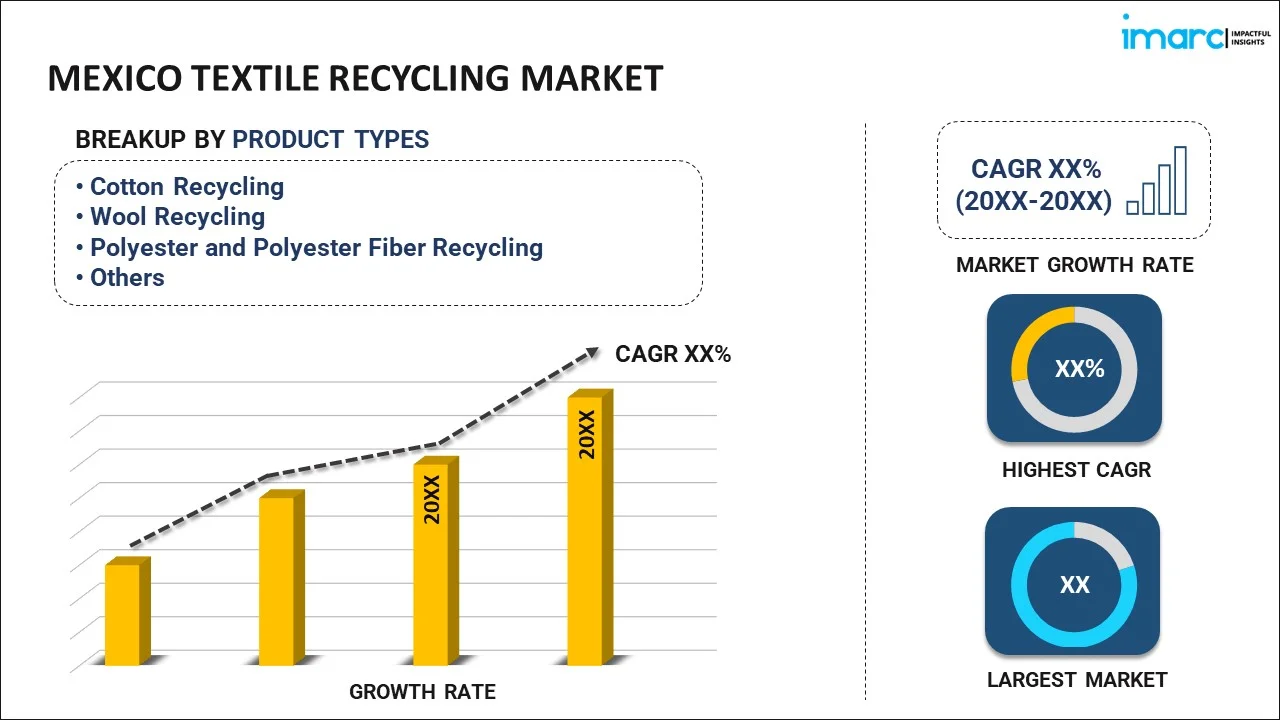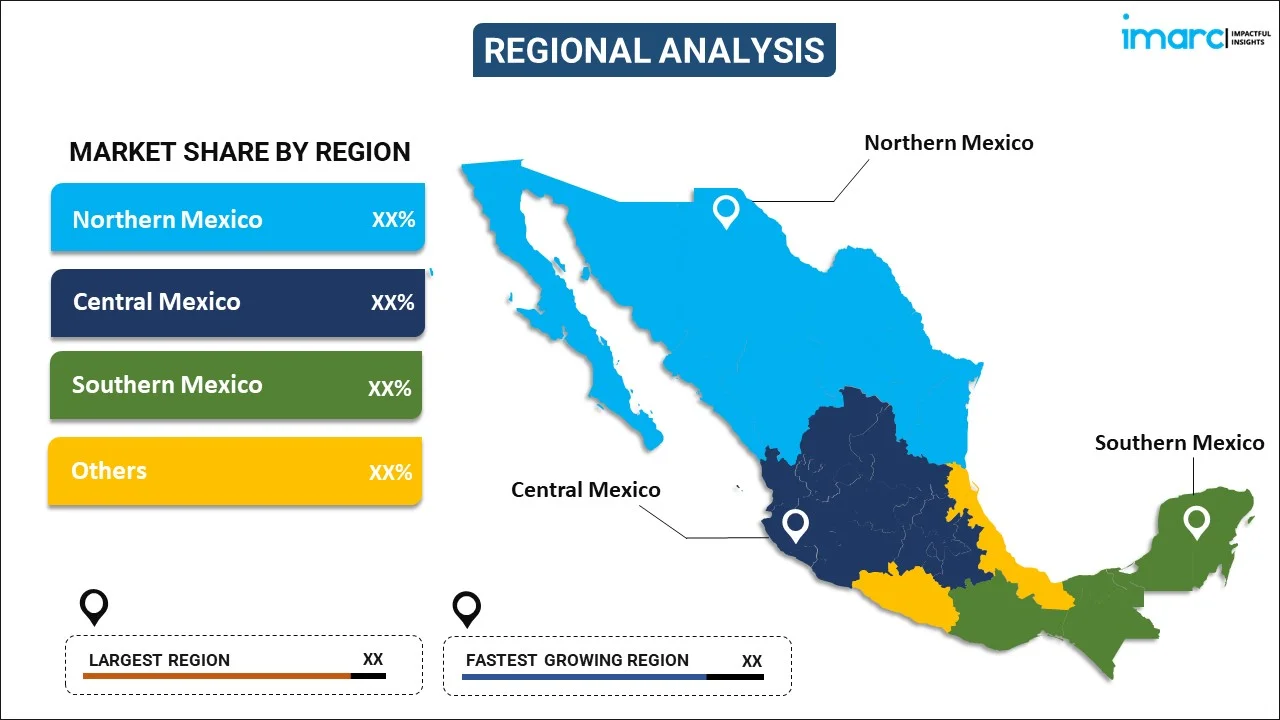
Mexico Textile Recycling Market Report by Product Type (Cotton Recycling, Wool Recycling, Polyester and Polyester Fiber Recycling, Nylon and Nylon Fiber Recycling, and Others), Textile Waste (Pre-consumer Textile, Post-consumer Textile), Distribution Channel (Online Channel, Retail and Departmental Store), End User (Apparel, Industrial, Home Furnishings, Non-woven, and Others), and Region 2025-2033
Market Overview:
Mexico textile recycling market size reached USD 70.2 Million in 2024. Looking forward, IMARC Group expects the market to reach USD 128.5 Million by 2033, exhibiting a growth rate (CAGR) of 6.44% during 2025-2033. The growing awareness and commitment to environmental responsibility, rising popularity of circular economy concepts, which emphasize the importance of recycling and reusing materials, and increasing technological advancements represent some of the key factors driving the market.
|
Report Attribute
|
Key Statistics
|
|---|---|
|
Base Year
|
2024 |
|
Forecast Years
|
2025-2033
|
|
Historical Years
|
2019-2024
|
| Market Size in 2024 | USD 70.2 Million |
| Market Forecast in 2033 | USD 128.5 Million |
| Market Growth Rate (2025-2033) | 6.44% |
Textile recycling is the systematic effort to divert textiles, such as clothing, fabric scraps, and household textiles, from the waste stream and transform them into usable materials. It involves mechanical recycling, wherein textiles are shredded into fibers by mechanically breaking them. It also encompasses chemical treatments used to dissolve and break down textile materials into their chemical constituents. It includes upcycling, which involves creatively repurposing old textiles into new products without significant structural changes. It begins with the collection, wherein individuals, businesses or organizations gather discarded textiles and then sort the material based on their quality, material composition, and potential for recycling. It reduces the need for raw materials and energy, mitigating these environmental impacts. It helps to minimize the impacts of textile production, which is resource-intensive and contributes significantly to water pollution and greenhouse gas emissions. Textile recycling can create local jobs in collection, sorting, and processing, contributing to the economy. It enables organizations to focus on recycling to support socially responsible initiatives, such as helping marginalized communities and reducing the exploitative practices of the fashion industry. It also helps to increase awareness among individuals and encourages them to make more sustainable choices and extend the lifespan of their clothing.
Mexico Textile Recycling Market Trends:
At present, the increasing awareness and commitment to environmental responsibility is driving the demand for textile recycling, as it offers a practical solution to reduce the carbon footprint of the fashion and textile industry in Mexico. Besides this, government regulations and policies aimed at reducing waste and promoting recycling are contributing to the growth of the market in the country. In addition, the growing popularity of circular economy concepts, which emphasize the importance of recycling and reusing materials, is gaining traction and encouraging businesses to adopt textile recycling for reducing waste and conserving resources. Apart from this, technological advancements are playing a pivotal role in making textile recycling more efficient and cost-effective, thereby encouraging its adoption among individuals and businesses of the country. The emergence of innovative recycling technologies, such as chemical and mechanical recycling processes, is making it possible to recover high-quality fibers from used textiles. Additionally, the rising environmental consciousness among the masses is increasing the adoption of eco-friendly practices and the reduction of fashion waste, which is strengthening the market growth. Moreover, major brands and fashion houses are committing to sustainability targets, aiming to reduce their carbon footprint and decrease waste generation.
Mexico Textile Recycling Market Segmentation:
IMARC Group provides an analysis of the key trends in each segment of the market, along with forecasts at the country level for 2025-2033. Our report has categorized the market based on product type, textile waste, distribution channel, and end user.
Product Type Insights:

- Cotton Recycling
- Wool Recycling
- Polyester and Polyester Fiber Recycling
- Nylon and Nylon Fiber Recycling
- Others
The report has provided a detailed breakup and analysis of the market based on the product type. This includes cotton recycling, wool recycling, polyester and polyester fiber recycling, nylon and nylon fiber recycling, and others.
Textile Waste Insights:
- Pre-consumer Textile
- Post-consumer Textile
A detailed breakup and analysis of the market based on the textile waste have also been provided in the report. This includes pre-consumer textile and post-consumer textile.
Distribution Channel Insights:
- Online Channel
- Retail and Departmental Store
The report has provided a detailed breakup and analysis of the market based on the distribution channel. This includes online channel and retail and departmental store.
End User Insights:
- Apparel
- Industrial
- Home Furnishings
- Non-woven
- Others
A detailed breakup and analysis of the market based on the end user have also been provided in the report. This includes apparel, industrial, home furnishings, non-woven, and others.
Regional Insights:

- Northern Mexico
- Central Mexico
- Southern Mexico
- Others
The report has also provided a comprehensive analysis of all the major regional markets, which include Northern Mexico, Central Mexico, Southern Mexico, and Others.
Competitive Landscape:
The market research report has also provided a comprehensive analysis of the competitive landscape. Competitive analysis such as market structure, key player positioning, top winning strategies, competitive dashboard, and company evaluation quadrant has been covered in the report. Also, detailed profiles of all major companies have been provided.
Mexico Textile Recycling Market Report Coverage:
| Report Features | Details |
|---|---|
| Base Year of the Analysis | 2024 |
| Historical Period | 2019-2024 |
| Forecast Period | 2025-2033 |
| Units | Million USD |
| Scope of the Report | Exploration of Historical Trends and Market Outlook, Industry Catalysts and Challenges, Segment-Wise Historical and Future Market Assessment:
|
| Product Types Covered | Cotton Recycling, Wool Recycling, Polyester and Polyester Fiber Recycling, Nylon and Nylon Fiber Recycling, Others |
| Textile Wastes Covered | Pre-consumer Textile, Post-consumer Textile |
| Distribution Channels Covered | Online Channel, Retail and Departmental Store |
| End Users Covered | Apparel, Industrial, Home Furnishings, Non-woven, Others |
| Regions Covered | Northern Mexico, Central Mexico, Southern Mexico, Others |
| Customization Scope | 10% Free Customization |
| Post-Sale Analyst Support | 10-12 Weeks |
| Delivery Format | PDF and Excel through Email (We can also provide the editable version of the report in PPT/Word format on special request) |
Key Questions Answered in This Report:
- How has the Mexico textile recycling market performed so far and how will it perform in the coming years?
- What has been the impact of COVID-19 on the Mexico textile recycling market?
- What is the breakup of the Mexico textile recycling market on the basis of product type?
- What is the breakup of the Mexico textile recycling market on the basis of textile waste?
- What is the breakup of the Mexico textile recycling market on the basis of distribution channel?
- What is the breakup of the Mexico textile recycling market on the basis of end user?
- What are the various stages in the value chain of the Mexico textile recycling market?
- What are the key driving factors and challenges in the Mexico textile recycling?
- What is the structure of the Mexico textile recycling market and who are the key players?
- What is the degree of competition in the Mexico textile recycling market?
Key Benefits for Stakeholders:
- IMARC’s industry report offers a comprehensive quantitative analysis of various market segments, historical and current market trends, market forecasts, and dynamics of the Mexico textile recycling market from 2019-2033.
- The research report provides the latest information on the market drivers, challenges, and opportunities in the Mexico textile recycling market.
- Porter's five forces analysis assist stakeholders in assessing the impact of new entrants, competitive rivalry, supplier power, buyer power, and the threat of substitution. It helps stakeholders to analyze the level of competition within the Mexico textile recycling industry and its attractiveness.
- Competitive landscape allows stakeholders to understand their competitive environment and provides an insight into the current positions of key players in the market.
Need more help?
- Speak to our experienced analysts for insights on the current market scenarios.
- Include additional segments and countries to customize the report as per your requirement.
- Gain an unparalleled competitive advantage in your domain by understanding how to utilize the report and positively impacting your operations and revenue.
- For further assistance, please connect with our analysts.
 Inquire Before Buying
Inquire Before Buying
 Speak to an Analyst
Speak to an Analyst
 Request Brochure
Request Brochure
 Request Customization
Request Customization




.webp)




.webp)












